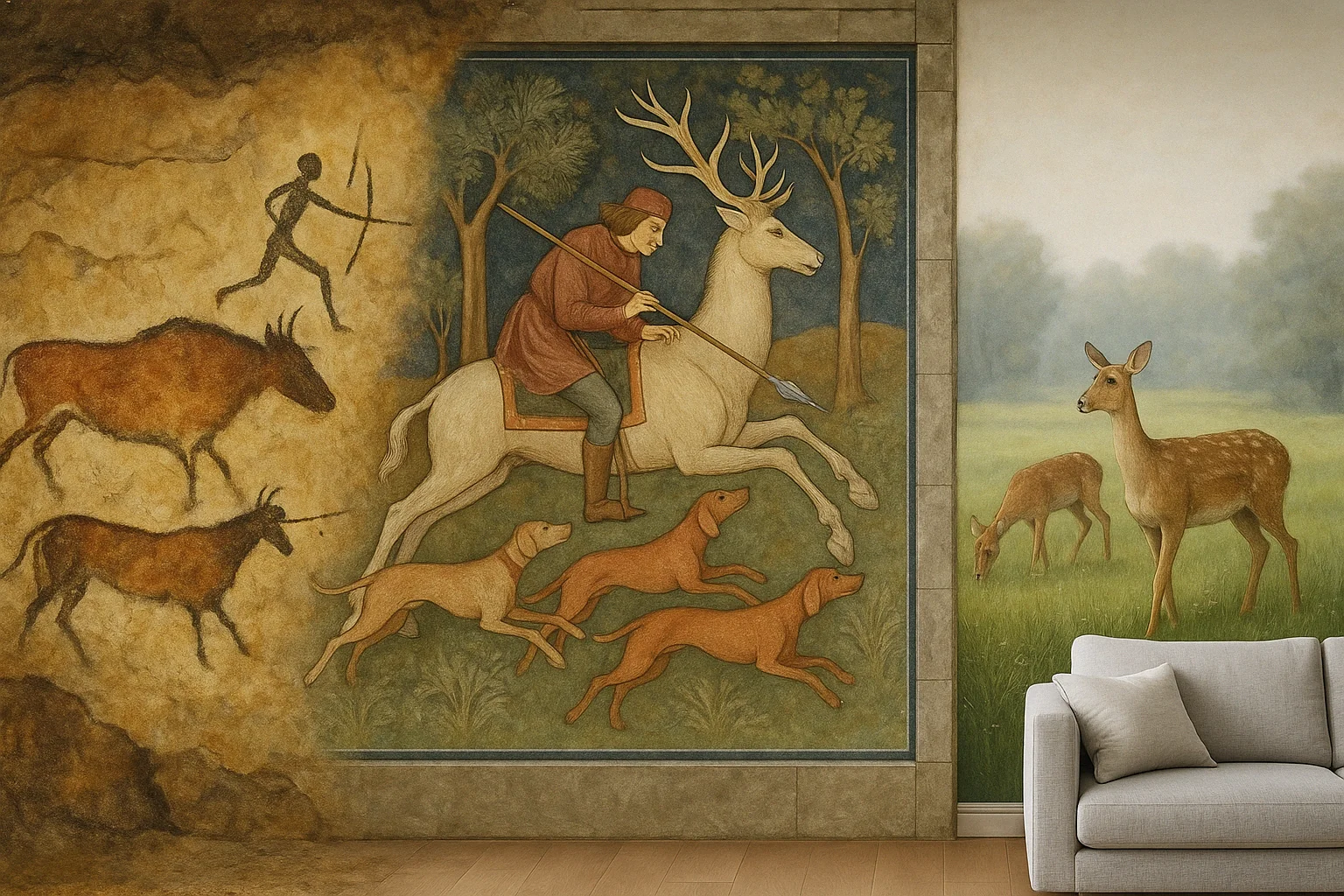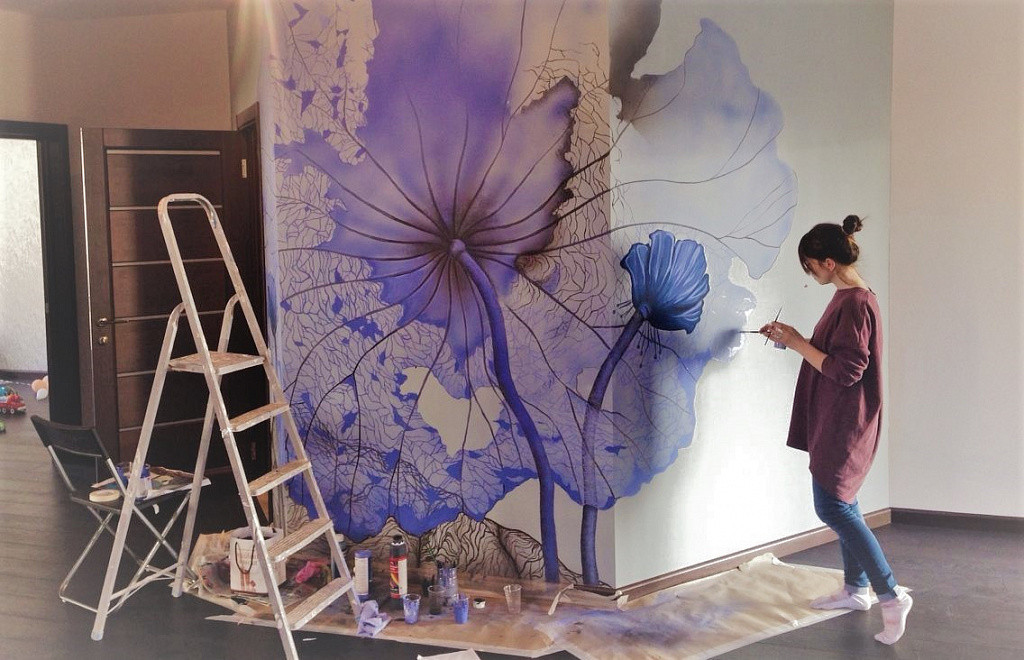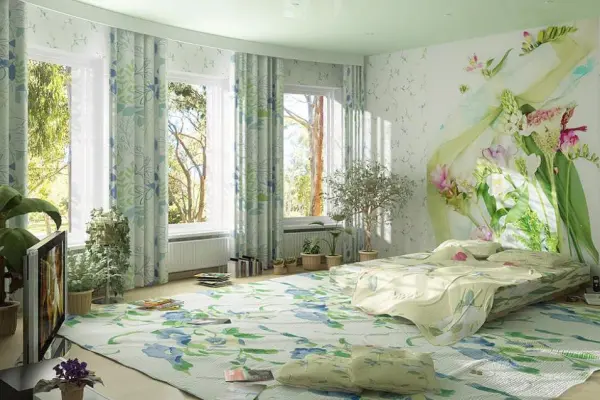Clients with refined taste place a number of strict requirements on the interior being designed. One of these concerns the originality of the techniques used. But is it so easy to create a space that’s "unlike any other"? Most design solutions are not one-of-a-kind. These are concepts based on already implemented projects. To create a unique home atmosphere, professional artists are brought in. Decorative wall painting allows for unique decoration of surfaces with various textures. This technique enables the creation of an interior with minimal costs that has no equivalents. People who have a distinct perspective on things and view the world through a creative lens often opt for such techniques.
"Wall painting by an artist is not just a decoration but an investment in your home’s uniqueness. In an era of mass production, handmade work becomes a luxury available to those who value individuality and are open to creative experiments in their interiors."
Ekaterina Morozova, monumental artist
It’s possible to bring projects of varying complexity to life. Such solutions allow for the decoration of surfaces not only in residential spaces but also in shops, cafes, restaurants, and trendy nightclubs. Hand-painted interiors are becoming increasingly popular among both private homeowners and commercial spaces. Wall painting by hand opens up endless possibilities for creativity and the realization of the boldest design ideas.
Wall Painting Techniques: From Ancient Times to Today
 Hand-painted walls use techniques that are centuries old. The art of fresco involves applying a design to wet plaster, resulting in vibrant and warm canvases. Even the highest-quality posters and wallpapers cannot achieve the desired effect. Only artistic wall painting can create the interior of your dreams. Frescoes are known for their durability—many cathedral walls painted using this technique have survived centuries in their original form. What’s the difference between a fresco and wall painting? A fresco is a specific type of painting on wet plaster, while modern painting can be done on pre-prepared dry surfaces using various paints.
Hand-painted walls use techniques that are centuries old. The art of fresco involves applying a design to wet plaster, resulting in vibrant and warm canvases. Even the highest-quality posters and wallpapers cannot achieve the desired effect. Only artistic wall painting can create the interior of your dreams. Frescoes are known for their durability—many cathedral walls painted using this technique have survived centuries in their original form. What’s the difference between a fresco and wall painting? A fresco is a specific type of painting on wet plaster, while modern painting can be done on pre-prepared dry surfaces using various paints.
Contemporary artists use both traditional and innovative materials for wall painting. Acrylic wall painting has become the most popular due to its versatility and durability. Acrylic paints allow for bright, vibrant colors resistant to fading. Stencil wall painting is also widely used for creating repeating elements and intricate geometric patterns. Stencils help even beginners create professional work, and wall painting techniques are constantly evolving, enabling new artistic effects.
Painting in Wall Decoration: Design Secrets
Wall painting is often chosen to bring bold, original ideas to life. Many designers use these methods to create unique visual effects. A small room can be visually enlarged by strategically placing a painting with an appropriate theme on the walls or ceiling. An overly large space can be visually reduced. If a room is too dark, it can be filled with light. Wall painting in an apartment should take into account the specifics of the layout and lighting.
It’s important to select materials suited to the room’s purpose. For example, eco-friendly, odorless paints are ideal for painting walls in a children’s room, while moisture-resistant compounds are better for kitchens or bathrooms. For more detailed information on caring for painted surfaces, we recommend reviewing materials from the Smithsonian Institution on art preservation, which provides professional advice on maintaining wall paintings in perfect condition.
Many wonder whether it’s possible to paint wallpaper rather than just bare walls. Yes, it’s possible, but it requires special preparation and primers to ensure paint adhesion. The type of wallpaper matters—vinyl and non-woven wallpapers are the most suitable. DIY wall painting is becoming an increasingly popular hobby for those who want to add individuality to their homes without significant expenses on professional artists.
Stages of Wall Painting: From Concept to Completion
The process of hand-painting an interior involves several sequential stages, each critical to the final result. Before starting, it’s important to understand how long wall painting takes. On average, decorating a 10-15 m² wall may take 3 to 14 days, depending on the complexity of the design and the technique used.
| Stage | Description | Features |
|---|---|---|
| Surface Preparation | Priming and leveling the wall | Requires a perfectly smooth surface without defects |
| Sketch Creation | Designing and transferring to the wall | Can be done by hand or with a projector |
| Base Color Application | Filling large color blocks | Uses wide brushes or rollers |
| Detailing | Drawing fine elements | Requires high precision and artistic skill |
| Final Coating | Applying protective varnish | Ensures durability and allows for wet cleaning |
This table outlines the sequence of work in creating a wall painting by an artist. Each stage requires a professional approach and specific skills, so it’s important to entrust this task to experienced professionals or thoroughly study the technique if you plan to paint walls yourself. Sketches for wall painting play a crucial role in the project’s success—without careful preliminary design on paper, achieving the desired result on the wall is challenging.
Wall Painting for Visual Effects
 One of the key aspects of hand-painted walls is their ability to create stunning visual effects in an interior. Designers and artists working with this technique can influence the perception of a room’s size and atmosphere. Wall painting ideas are often based on an understanding of optical perception and color psychology.
One of the key aspects of hand-painted walls is their ability to create stunning visual effects in an interior. Designers and artists working with this technique can influence the perception of a room’s size and atmosphere. Wall painting ideas are often based on an understanding of optical perception and color psychology.
- Enlarging and Reducing Space: Custom wall painting can visually alter a room’s size. For example, light tones and vertical lines can make a small room feel taller. Conversely, warm colors and horizontal elements can make a spacious room feel cozier.
- Creating a Specific Atmosphere: Three-dimensional wall painting can also affect a room’s ambiance. For instance, paintings with marine themes can evoke calm and relaxation, while abstract, vibrant patterns can create a dynamic and energetic mood.
- Playing with Light and Shadow: Artists can use light and shadow to add volume and depth to walls, creating a unique three-dimensional effect that makes the interior more engaging and lively. Wall painting in bedrooms often uses these techniques to create a relaxing atmosphere. Volumetric drawings on walls can achieve a sense of presence, whether depicting landscapes, architectural elements, or fantastical scenes.
Each room can have its own painting style. Kitchen wall painting often includes botanical or culinary motifs, while antique-style wall painting is commonly used in classic living rooms and dining areas. Turnkey wall painting involves a comprehensive approach, where the artist not only designs but also fully executes the project, including surface preparation and final coating.
"When choosing paints for wall painting, pay attention not only to aesthetic qualities but also to eco-friendliness. Modern water-based acrylic paints are not only safe but also offer excellent coverage and durability, which is especially important for high-traffic areas."
Alexander Petrov, paint technology expert
Success Story: Transforming an Urban Apartment
The Ivanov family struggled to decide how to decorate the main wall in their living room. Wallpaper seemed too mundane, and photo wallpapers didn’t fit the overall interior concept. After consulting with a designer, they opted for artistic wall painting.
"We chose an abstract design with elements of monumental painting that perfectly highlighted our apartment’s architectural features," says Elena Ivanova. "The artist worked on the painting for five days using special acrylic paints. The result exceeded all expectations—our living room is now the focal point for all our guests. Many friends, inspired by our example, have also decided to paint their walls. Most importantly, we got a truly unique interior that perfectly reflects our taste and lifestyle."
Modern Trends in Wall Painting
 The world of design is constantly evolving, and wall painting is no exception. Recent years have brought new trends and ideas that give wall painting a modern, stylish look. Historical sources of inspiration, such as the Victoria and Albert Museum’s wall painting collection, often serve as a starting point for modern interpretations of classic motifs. Mural painting, which has moved from the streets to home interiors, is becoming increasingly popular among younger clients.
The world of design is constantly evolving, and wall painting is no exception. Recent years have brought new trends and ideas that give wall painting a modern, stylish look. Historical sources of inspiration, such as the Victoria and Albert Museum’s wall painting collection, often serve as a starting point for modern interpretations of classic motifs. Mural painting, which has moved from the streets to home interiors, is becoming increasingly popular among younger clients.
- Minimalism and Geometry: One modern trend is the use of minimalism and geometric patterns. Simple, clean lines, geometric shapes, and abstract compositions give walls a modern, understated look. Stencil painting is often used to create precise geometric patterns with high accuracy.
- Natural Elements: More designers are incorporating natural elements into wall painting, such as depictions of nature, branches, flowers, or marine motifs. These elements bring a sense of closeness to nature and create a harmonious atmosphere. Botanical motifs are especially popular for wall painting ideas. Eastern motifs also resonate with fans of exotic and ethnic styles.
- Interactive Painting: Modern technologies enable interactive wall painting, such as designs that respond to movement or lighting, adding dynamic flair to interiors. These solutions are used in art studios and office wall painting, where impressing visitors is key.
The cost of artistic wall painting depends on many factors, including the scale of the work, design complexity, and the artist’s reputation. Custom interior wall painting is typically priced per square meter, ranging from $30 to $300 depending on the technique and detailing. Wall painting workshops often demonstrate cutting-edge techniques like sgraffito or texture imitation, which create stunning visual effects.
or lighting, adding dynamic flair to interiors. Such solutions are used in office and public space wall painting.
Wall painting workshops often demonstrate cutting-edge techniques like sgraffito or texture imitation, which create stunning visual effects.
Global Wall Painting Market Statistics
| Metric | Value | Comment |
|---|---|---|
| Market Size (2024) | $63.61 billion | Global wall art market |
| Market Forecast (2032) | $118.79 billion | Growth of over 1.8 times |
| Compound Annual Growth Rate (CAGR) | 8.55% | Stable growth over the forecast period |
| North America Market Share | 43.75% | Leading region in 2024 |
| Residential Segment Share | 71.2% | Most popular painting segment |
These statistics confirm the growing global popularity of artistic wall painting. The residential segment is particularly thriving, with more people favoring unique designs over standard solutions.
"From my experience, choosing how to seal a wall painting is one of the most critical questions for its longevity. The best modern polyurethane varnishes can protect the artwork for decades, preserving color vibrancy and allowing wet cleaning without risking damage to the artistic layer."
Mikhail Kuznetsov, restoration artist
Interesting and Little-Known Facts About Hand-Painted Walls
- Prehistoric Airbrushing: Over 40,000 years ago, prehistoric artists in France used hollow bird bones to spray paint on cave walls, creating stencil images of hands—the ancestors of wall painting. Modern airbrushing on walls continues this ancient tradition.
- Expensive Blue Pigments: Until the 18th century, blue shades were derived from semi-precious stones like lapis lazuli and azurite. Such paints were only affordable to wealthy clients and symbolized luxury. Today, fresco imitations often use these historical color schemes.
- Roman Fresco Mastery: Roman wall paintings often involved up to seven layers of plaster, with marble powder used in the final layers for a mirror-like shine and durability. This technology largely inspired modern textured painting.
- Women Muralists: In the 1970s, a group of Latin American artists, Las Mujeres Muralistas ("Women Muralists"), emerged in San Francisco, challenging male dominance in street art. Their mural-style works became a vital part of urban culture.
Wall painting or photo wallpaper—which is better? This question often arises when planning an interior. Photo wallpapers are cheaper and quicker to install, but hand-painted walls create a truly unique, personalized design that cannot be replicated.
Budgeting and Cost Calculation for Wall Painting
 When planning artistic wall painting, it’s important to understand the cost structure and prepare a budget in advance. The cost of wall painting can vary significantly depending on multiple factors:
When planning artistic wall painting, it’s important to understand the cost structure and prepare a budget in advance. The cost of wall painting can vary significantly depending on multiple factors:
| Factor | Impact on Cost | Price Range (USD) |
|---|---|---|
| Design Complexity | Detailed designs are more expensive than abstract ones | +$15-150 per m² depending on complexity |
| Artist’s Experience | Renowned artists charge significantly more | $30-300 per m² |
| Materials Used | High-quality imported paints increase costs | +$5-30 per m² |
| Surface Preparation | Often charged separately | $10-25 per m² |
| Painted Area Size | Large areas often have per-m² discounts | 10-30% discount for areas over 20 m² |
These prices are indicative and can vary significantly depending on geographic location, the country’s economic level, and the artist’s specific requirements. When budgeting, it’s recommended to request multiple quotes from different contractors for comparison.
Comparing Wall Painting with Other Wall Decoration Methods
Before choosing wall painting as a finishing method, it’s helpful to compare it with other popular wall decoration options:
| Criterion | Wall Painting | Photo Wallpaper | Decorative Plaster | Vinyl Wallpaper |
|---|---|---|---|---|
| Uniqueness | High (100% original design) | Medium (possible repetition) | Medium (standard textures) | Low (mass production) |
| Durability | 10-20+ years (with protective coating) | 5-7 years | 7-15 years | 3-7 years |
| Cost per m² | $30-300 (depending on complexity) | $15-60 | $20-100 | $5-30 |
| Implementation Time | Several days or weeks | Several hours | 1-3 days | 1-2 days |
| Repairability | Medium (restoration possible) | Low (full replacement) | High (local repairs) | Low (full replacement) |
This comparison table illustrates why, despite the higher cost, artistic wall painting is often the most cost-effective solution in the long term due to its durability and uniqueness.
Tips for Choosing an Artist or Studio for Wall Painting
 Choosing the right contractor is one of the key factors in a successful wall painting project. Here are some practical tips to help you find the right artist:
Choosing the right contractor is one of the key factors in a successful wall painting project. Here are some practical tips to help you find the right artist:
- Review Their Portfolio—examine at least 10-15 of the artist’s works, paying attention to style, quality, and variety of techniques. Choose an artist experienced in the style you want for your space.
- Request Reviews—ask for contacts of previous clients to learn about their experience working with the artist.
- Create a Detailed Brief—clearly outline all your expectations, including style, color scheme, theme, and deadlines. The more detailed your brief, the less likely misunderstandings will occur.
- Discuss the Process—clarify whether the artist will provide preliminary sketches, how approvals will work, what’s included in the cost, and what is charged separately.
- Sign a Contract—always formalize a written agreement specifying all key terms: cost, deadlines, revision process, and warranty obligations.
These steps will help minimize risks and ensure the final result aligns with your expectations.
Conclusion
Hand-painted walls are a powerful tool for transforming interiors and creating a unique atmosphere. When choosing artistic wall painting, consider the visual effects it can create and stay updated on modern trends to keep your interior stylish and relevant. Don’t be afraid to experiment and express your individuality through decorative wall painting.
Whether it’s three-dimensional wall painting, interior graffiti, or classic marble-style painting, each technique has its own characteristics and applications. Consider the interior style, the room’s function, and your personal preferences when choosing a painting design. If you’re unsure of your artistic abilities, you can always commission a professional artist to bring your ideas to life while addressing all technical nuances.

